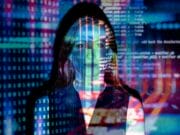With the ever-increasing advances in technology, cyber-attacks have been on the rise in recent years. A broad estimation is that cyberattacks cost the United States trillions of dollars every year. Machine learning is one method to combat cybercrimes. We will be discussing the importance of machine learning, and how it is being used to keep our networks and devices safe.
Machine Learning Explained

With so many cybercrimes getting committed every day, there are too many for humans to stop on their own. Even large cybersecurity companies can only work so quickly to stop hackers. Machine learning involves computers assisting with the workload that humans cannot keep up with.
As a type of artificial intelligence, machine learning consists of the computer recognizing patterns and creating algorithms. Machines can be taught to scan huge sets of data in a fraction of the time it takes humans to do the same thing. The machine can also spot irregularities, patterns, and make informed decisions about what to do with the patterns they have found.
The algorithms comprise prior data, which helps prevent any similar attacks from taking place in the future. The data needs to be as complete as possible from a variety of different sources to make the most accurate projections.
Machine learning makes finding security threats easier to do and it makes compiling huge amounts of data easier. The machine cannot learn without humans teaching the machine everything it needs to know. Machines can process data faster than the human brain, but they cannot recognize anything they are not taught to recognize.
Recommended for you: How AI & Machine Learning are Affecting the Future of eCommerce?
Why is Machine Learning So Beneficial?

With machine learning, computers are processing data to identify potential trends. They are slowly but surely getting better at recognizing scams such as phishing emails and online bank fraud and detecting malware.
Thieves and computer hackers are constantly making changes in the programs they use and the ways they access data that companies mean to be private. Machine learning allows the computers to not only recognize what they have seen before, but they can recognize things they have not seen before, and their human counterparts can teach the machine what they should do if they see the same data pattern happen in the future. Machines are quick students who never get tired, never lose their enthusiasm, and retain everything that they are taught.
Computers learn to conduct routine tasks much quicker than humans. It means that cybersecurity employees can focus on proactive strategies to avoid further attacks. The computer is also able to constantly scan the network for any vulnerabilities or attempted security breaches. In most cases, the machine learning algorithms analyze the data and humans make the final decision on how to proceed. In other cases, the computer can choose the response to take.
Examples of Machine Learning

Detecting Network Threats

If there is a great deal of network traffic daily, it can be difficult to identify nefarious visitors. Security tools that use machine learning can examine the IP addresses and techniques of hackers from the past and cross-references these identifiers to the current situation. If they notice any similarities, the computer will send out an alert, indicating that there are signs of a known attacker on the network. This alert will also go off if an unauthorized individual is attempting to hack into a classified account.
Unfortunately, there are not only threats from external sources to contend with. With the rise of jobs in cybersecurity, companies will make a new hire and later find that the individual was attempting to hack into the network from the inside. To avoid this, a good idea is to run a public data check on any new candidate that you are seriously considering. This will bring up their criminal record report, and you could see if they committed similar crimes in the past.
Protecting Against New Viruses

There are millions of new viruses that launch into society every year. Some of these malware strains operate without binary files, resulting in them being very difficult to detect. This makes it easier for the malware to infiltrate devices and wreak havoc on company systems.
Machine learning can detect hidden malware that traditional anti-virus software might miss. AI algorithms can analyze the source code of malware to determine its legitimacy and block it if required.
Machine learning is capable of stopping the viruses being used today, and the viruses that will be launched in the future. Your typical anti-virus software is out of date by the time you purchase it from the company because the would-be intruders developing the viruses never stop.
Enhancing Monitoring for Email Scams

Many companies already have email monitoring software in place to protect against phishing scams. Sometimes it can be difficult to determine if a message is legitimate or not, especially if a co-worker sent it. There is always the chance that a hacker infiltrated their email address and sent the message. Machine learning is helpful in this regard. Because it can analyze the links, texts, and attachments in an email and scan for disreputable content.
Most employees realize that emails from outside of the office can bring viruses into the system, but they often do not realize that inner-office notes, correspondence, and emails can also be infected. Educational programs established to educate employees on what to be looking for or suspicious of can protect your company.
You may like: Artificial Intelligence Aided Machine Learning – The Future of Reality.
Methods of Improving Cybersecurity

Working alongside a cybersecurity company is one method of defending against hackers, but there are several more tips that you can start implementing today at your business. Utilizing your in-house rules and regulations concerning internet access, file storage, emails, and inter-office correspondence can strengthen your security and help your employees understand the need for their cooperation and diligence in protecting information.
Create Backups

If a hacker managed to upload ransomware onto your system, all your files would be at risk. The hacker would hold them as hostages until you pay them to retrieve access. To avoid this scenario, make frequent backups of all your files. Some companies choose to use external hard drives for this purpose and back up their work daily, weekly, or monthly.
If you choose to back up your files on the desktop or the Cloud, make sure that you securely encrypt them to fend against hackers.
Use Secure Networks

An important tip is to make sure that your employees never use an unsecured network for work. Unsecured networks are incredibly vulnerable to attack; hackers can easily access any usernames, passwords, or documents downloaded while the individual is on the network. In the office, you should set up two different WIFI connections. One of them should be public for guests, and the other should be private, for employees only.
Unsecured networks allow everyone that is on the network to see what your employee is doing and who they are talking to. In a matter of seconds, a talented computer hacker can gain access to your company files by gaining access through your employee’s computer.
Your employees are not automatically aware of this problem. Most people think if they use their laptop to work while visiting their family in the hospital or while they are waiting in line to pick their child up from school that their information is secure, and password protected. The only way your employees can know how to be safe is for you to hold teaching and learning clinics that will help them know what is dangerous and how to avoid dangerous situations.
Enforce Strong Passwords

One of the most important tips to remember is that strong passwords are essential. Short or easy-to-guess passwords are an open invitation to hackers. They should not contain any personal or company information; they should ideally be a random assortment of letters, numbers, and symbols. All employees should change their password every three months and immediately if they get a notification of an attempt to access the account. Everyone should also change their passwords when an employee leaves to prevent them from trying to access files without authorization.
It is wise if the employees have a method of retrieving lost passwords that cannot be infiltrated by a hacker. Your company can set up an email account that is only accessible by a high-ranking official in the company. If an employee has to retrieve their password they can use that backup email; the officials that regulate the account can help them to get their password.
Once a password has been lost or compromised then another password must be used. Teaching your employees to establish passwords that are secure and hard to penetrate will require some patience. Most people do think their initials, their phone numbers, their parent’s names, and such are things that only they know.
Educating your employees on password security protocol should be done immediately after hiring them. Repeat or refresher courses that help your employees to remember everything they should know about passwords, email accounts, and common security issues should happen on a regular basis.
You may also like: The Growing Need for Cybersecurity: 10 Tips to Stay Protected Online.
Conclusion

There will always be a larger number of cybercriminals as compared to cybersecurity agents. Machine learning and continuous improvements are our best bet against hackers and the damage that they cause. Keep your business as safe as possible by improving all the cybersecurity processes that you can. If you come to a standstill, working with a cybersecurity company might be your next step.





